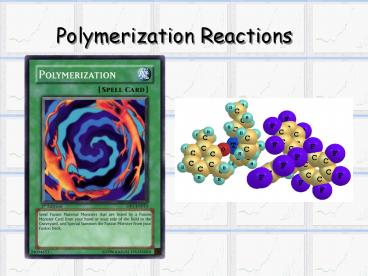Polymerization Reactions - PowerPoint PPT Presentation
1 / 18
Title:
Polymerization Reactions
Description:
Title: Slide 1 Author: Julie.Sorensen Last modified by: Administrator Created Date: 4/12/2004 5:48:03 PM Document presentation format: On-screen Show (4:3) – PowerPoint PPT presentation
Number of Views:356
Avg rating:3.0/5.0
Title: Polymerization Reactions
1
Polymerization Reactions
2
(No Transcript)
3
What is Polymerization?
- Polymerization is a process in which very small
molecules, called monomers, combine chemically
with each other to produce a very large chainlike
molecule, called a polymer.
4
(No Transcript)
5
How are the pictures of DNA different? Identify
the trimer of DNA. What are the cross-linkers?
6
The First Polymerization
- The first synthetic polymer was discovered in
1909 by Leo Backeland, a Belgian-born US Chemist.
- It was marketed under the trademark Bakelite,
which was made from phenol and formaldehyde. - It became an important plastic and resin for
adhesives, and paints.
7
Polymerization Types
- There are two main types of Polymerization
reactions - Addition
- Condensation
2 2
Think water, although that is not always the case
8
Addition Polymerization
- In Addition Polymerization, monomers form without
a by-product, such as water.
- The structure has one structural unit, or
monomer, that occurs repeatedly.
- The monomer molecules may be all alike, or they
may represent two, three, or more different
compounds. The Addition Reaction involves only
double and single bonded compounds.
9
Addition Polymerization
- Through polymerization of ethylene (ethene),
CH2CH2, the structure of the polymer can be
represented by -(CH2CH2)n- where n can be several
thousand.
- Example
- H H H H H H H H H H H H
-
- CC CC CC gt C-CC-CC-C
- H H H H H H H H H H H H
- ethylene part of polyethylene
- In 1839, American chemist Charles Goodyear
discovered - that natural rubber could be cross-linked with
sulfur. - This process was known as vulcanization.
10
How are Free Radicals Used in Polymerization?
Free-Radical Addition is another type of
polymerization reaction. This is when the
polymer is induced (started) by an initiator,
which is a compound that produces free radicals
11
What Free Radicals Are NOT
Hey, these radicals Are still free! Dont They
need to be Arrested?
12
What Free Radicals Are NOT
Ah, Out from under at last!!!
2
Your math teacher would not approve
13
What a Free Radical IS
- Free-radicals are species that have an unpaired
electron.
14
What does an unpaired electron mean?
Remember the electron configuration thing?
Well, an unpaired electron is when An orbital
has only an electron with one spin (either 1/2
or -1/2) Example 1s2 2s1 Example
1s22s22p5 In a compound an UNPAIRED electron
is one that is unbonded
15
Condensation Polymerization
- In condensation polymerization, two functional
groups of two different monomer molecules are
joined together which produces a small molecule
such as water. - The monomers bond where the hydrogen atoms were
taken out to produce water. - In order to become a condensed polymer, the
monomer molecules must have at least two
functional groups.
16
Condensation Polymerization
- The reaction between a carboxylic acid and an
alcohol creates an ester. - If the carboxylic acid and the alcohol were the
monomers of the polymer, during polymerization,
they would create polyester, and produce water.
17
Condensation Polymerization
- Example of condensation polymerization
- Curing of concrete
- There are several types of materials that form by
Condensation Polymerization, including nylon,
polyesters, rayon, and spandex.
18
(No Transcript)































